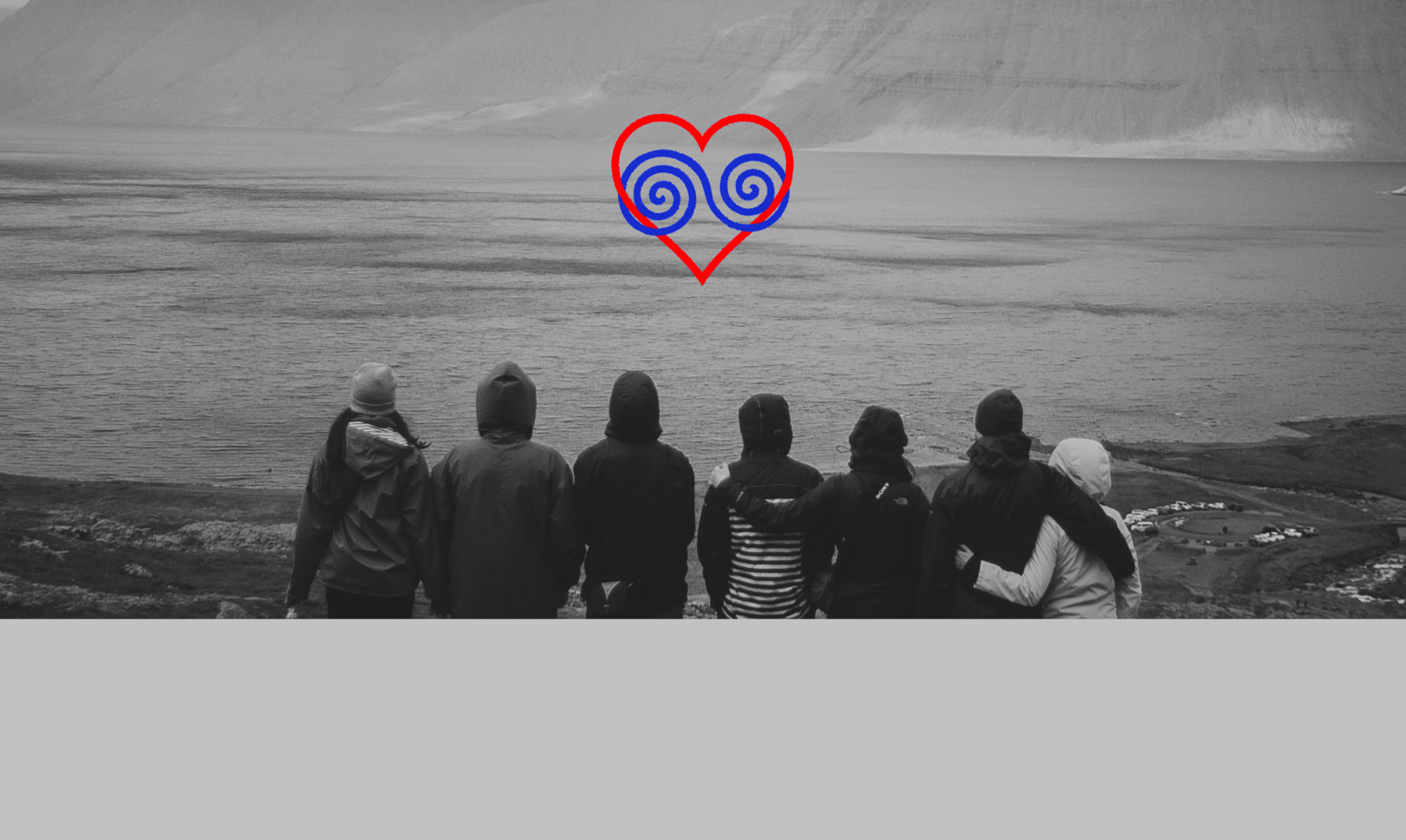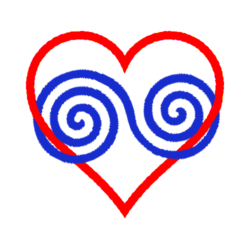Indivisible – or: Amidst it all

There’s that old joke about the Zen master at the snack bar who, when asked how many sandwiches he’d like and what their toppings should be, replies, “One with all!”
Which is a beautiful and very oligoamorous answer, as I would like to confirm in this Entry due to recent events – and thereby dedicate my article at the same time to the Buddhist monk, writer and non-violent communicator Thích Nhất Hạnh, who passed away on January 22nd this year.
Because also in January of this year I was once again entangled in one of my explain-brain conversations about Oligo- and Polyamory, which – alas!– was met with only limited appreciation by my counterpart. My interlocutor had listened to my approach to ethical multiple relationships for a while, but finally spoke: “Personally, in a lonely hour, I could perhaps imagine having two men for myself at once, dancing to my tune. But to share even with one (or even more) other women would be unthinkable for me.”
As I do not usually act as a missionary in such matters and grant every human being the right to his*her own opinion in these matters, some time later I smilingly dealt again with this statement on my own – which after all contains some grave indicators of how we still often enough think about our own value, the significance of other people, the specific purpose of relationships and our standing in the world at large. And frighteningly, for the most part, this is still rather violent, as the communication expert Marshall Rosenberg would probably have analysed.
So at this point I could be prompted to remark that it would belong to the very core of ethical multiple relationships never to regard other people as a resource which one needed to seize in order to have them completely “for oneself”. Or that you should never assign the task of “Siri” or “Alexa” to your loved ones in order to have them “dance to your tune”.
In the same way I could also say amusedly that already since the 5th century before Christ in ancient Greece considerations developed that there certainly had to be things in the universe which are “atomic”, which means indivisible. Among which I would count healthy human personalities on the whole. And here on this bLog I have already mentioned that we humans indeed should share several things with each other (e.g. according to Gerald Hüther in Entry 4: our food, our habitat, our attention, our strength, our knowledge, our ability, our experience). Our very “self” on the other hand, there I have always taken a very clear position within my Oligoamory: That should always be as “whole” as possible – and each of our loved ones should be able to depend on experiencing ourselves as “complete”, 100% present and fully invested.
In the upper statement of my former dialogue partner, therefore, also the fear can be heard which so often accompanies thoughts about multiple person constellations in matters of love: to vanish as a valued individual in such a relationship-mingle, to get lost out of beloved eyes, to fall victim to interchangeability and arbitrariness. And with it also the apprehension to become a kind of “resource” oneself, which may contribute to all-round well-being and sunshine if required – but is thrown back alone and into darkness in case of own woe.
And this fear is not absurd or far-fetched. In Entry26, I quote the Swiss relationship researcher and coach Daniel Hess as well as the anthropologist Jean Liedloff, who call this contemporary phenomenon our everyday “reality of separation”. Because in our “normal lives” we all still very predominantly experience that matters are supposed to exist distinctly separated from each other. Yes, “have to” exist like this in order to avoid an elusive, somehow irregular vagueness. This applies to concepts, to property, hierarchies, and thus also relationships. “This” or “that,” “mine” or “yours” – the importance of these categories determines our existence in Western industrial nations from childhood on.
Clever minds like Daniel Hess or Jean Liedloff, however, would like to remind us that these categories are thoroughly artificial, man-made divisions – and that they do not contribute to our well-being in the long run. On the contrary, this artificially constructed “reality of separation” keeps us from our authenticity, from fearlessness, from genuinely assuming responsibility for our lives, indeed, from our full dignity as human beings.
“Division” and “separation” are thus the crutches by which we drag ourselves through our daily lives – eventually through a self-created maze of grey cul-de-sacs.
“Wholeness” would therefore be the much healthier goal – that is, becoming whole et least – or “being” whole at last. The point is to achieve a state of greatest possible contentedness, which I also wish to bring about with my oligoamorous relationships.
Yet we are often afraid of it because we are quick to believe that the price of wholeness might be this very dreaded “getting lost.”
In this respect, the Lebanese-US philosopher and poet Khalil Gibran once wrote the following text¹:
It is said that before entering the sea
a river trembles with fear.
She looks back at the path she has traveled,
from the peaks of the mountains,
the long winding road crossing forests and villages.
And in front of her,
she sees an ocean so vast,
that to enter
there seems nothing more than to disappear forever.
But there is no other way.
The river can not go back.
Nobody can go back.
To go back is impossible in existence.
The river needs to take the risk
of entering the ocean
because only then will fear disappear,
because that’s where the river will know
it’s not about disappearing into the ocean,
but of becoming the ocean.
Stirring words, to which I would like to say, applied to ethical multiple relationships: It is not a matter of drowning in a tangled thicket of relationships, but rather – once we have decided to do so – to wear our relationship philosophy inside out, to access it for ourselves and to inhabit it like a second skin, to embrace it every day with our whole being.
So we are supposed – in a way – to “be” our relationships? How would such a thing be even remotely possible?
To accomplish this, we have to think our way out of our self-constructed reality of separation – and in my view, no one has expressed this better so far than the Buddhist wisdom teacher Thích Nhất Hạnh mentioned at the beginning of this article.
For the corresponding mindset, he coined the term “inter-being”, which I would rather translate as “being in the midst of” or “being in the midst of” instead of “being in between”.
The term is an approximation of the Vietnamese words tiep hien. Thich Nhat Hanh wrote in his book “Interbeing: Fourteen Guidelines for Engaged Buddhism” (Parallax Press, 1987) that tiep means “to be in contact with” and “to proceed”. Hien means “to realize” and “to do it here and now”.
Indeed, a fundamental Buddhist teaching called Pratityasamutpada, or “dependent arising,” states that all phenomena are interdependent.
The essence of this view is that nothing has an independent existence ( in agreement with which I already contradict Osho in Entry 8). Whatever exists comes into being because of factors and conditions created by other phenomena.
Thích Nhất Hạnh devoted his whole life to Mahayana Buddhism, in particular to a school of thought that is called “Madhyamika“ – in a sense the “middle way” – and which is mainly concerned with the nature of existence.
The Madhyamika states that nothing has an intrinsic, permanent self-nature. Instead, all phenomena – including beings (and, of course all people) – are temporary confluences of conditions that take identity as individual things from their relationship to other things.
Complicated? In Entry 57, I choose a baby rattle as a symbol for this synergy – Barbara O’Brien, an expert on Zen Buddhism, chooses a plain wooden table to illustrate this:
»It is an assembly of parts. If we take it apart piece by piece, at what point does it stop being a table? If you think about it, this is a completely subjective perception. For example, one person might assume that there is no longer a table as soon as it can no longer be used as a table; another person, on the other hand, might look at the pile of wooden parts and still recognize the table in it: “That’s just a disassembled table…”
The point is that the mere arrangement of the parts doesn’t actually have an independent table-nature; it’s a table because we think it is one. “Table” is in our minds. A species other than us might recognize in the collection of parts food or a hiding place or merely something to mark territory.« ²
In his book, “The Miracle of Mindfulness” (Beacon Press, 1975), Thích Nhất Hạnh wrote that “people intentionally cut reality into different compartments and are therefore unable to recognize the interdependence of all phenomena. In other words, because we think of ‘reality’ as a lot of discrete objects, we don’t consider how they actually interconnect.
But when we perceive interbeing, we see that not only is everything interconnected; we see that all is one and one is all. We are ourselves, but at the same time we are all each other.”
Thích Nhất Hạnh’s wisdom – or rather his clever Buddhist interpretation of these over 800-year-old ideas – is thus in excellent company, by the way:
Not only in that of my favourite early modern philosopher Anthony Ashley Cooper in Entry 64, who for his part stated during the 17th century in an almost ecological manner that “a single being as a ‘private system’ is always likewise integrated into ‘more comprehensive systems’, whereby the systems support one another and thus stand to each other and likewise to the totality in a relationship of all-round beneficial interaction.”
But also in that of Mahatma Gandhi‘s famous reverse conclusion: “You and I are one: I cannot hurt you without hurting myself” (first quoted here in Entry 54).
However, equally in quite modern contexts such as that of Holism (Entry 57), which states that “natural systems or even non-natural, e.g. social systems and their properties are to be considered as a whole and not merely as a composition of their parts, and therefore could not be fully understood from the interaction of all their individual parts, and that the determination of the individual parts depends on their functional role in the whole” (definition Wikipedia Germany).
Or likewise – to arrive completely in our cutting-edge present time – in accordance with the “theory of complex-adaptive systems“, which are indispensable for computer and AI research. Which exactly are considered complex because they consist of several interrelated elements and that they are adaptive by showing a particular capacity to adjust to their environment – thereby demonstrating the ability to learn from experience.
A cybernetics scientist would probably also include emergence (the possibility of the formation of new properties or structures of a system as a result of the interaction of its elements) and self-organization in this context, which brings us unexpectedly back…
…to the dance floor of multiple relationships, on which, in turn, social scientists attest the greatest sustainability to precisely THOSE communities and relationships that prove to be heterogeneous (= diverse), adaptive, willing to learn, cooperative and mutually supportive.
“Wholeness” or becoming whole are thus absolutely no detached esoteric or merely spiritual concepts. Becoming whole means the greatest possible integration ( involvement) in the sense of the community researcher Scott Peck, who already wrote in 1984:
“Integration does not mean equalizing; it does not result in an overcooked stew. Rather, it can be compared to a salad dish whose individual ingredients retain their identity, only to be highlighted when combined.” ³
So our favourite people, our loved ones and we, we never exist separately, we intentionally form a common whole; their needs are also our needs, from their well-being ours emerges. Or to say it again similar to David Mitchell in his “Cloud Atlas“ : “By every kindness we create our common future with each other.” One with all – and in the midst of it.
¹ Khalil Gibran: “Sand and Foam, Selected Poems”, 1926
² Thanks to Barbara O’Brien; expert on Zen Buddhism and her “Rethinking Religion”-Project, by which she contributed much to my understanding of a complex philosophy.
³ Scott Peck: The Different Drum: Community Making and Peace (Simon & Schuster, 1987) ISBN 978-0-684-84858-7
Thanks to Alex Alvarez on Unsplash for the picture!

